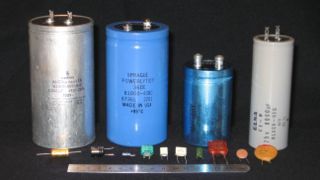Supercapacitors as Energy Storage Devices
A young, bright, and extremely respectful friend sent me this video on supercapacitors a few hours ago. And, since he had been very active in communicating with me lately, he wrote, “Tell me to shut up if I get to be a problem.” I respond:
Ha! You’re NEVER a problem. Trust me. I have problems, and you, my friend, are not one of them.
Having said that, supercapacitors are super-hyped, IMO. Yes, the rate at which energy can be charged and discharged (i.e., power) is limited with batteries. But this isn’t the factor that is limiting the success of the technologies that will change our world. Would it be of great benefit if you could charge your cell phone in 30 seconds, or discharge its battery more quickly? No.
When it comes to this subject, there are two issues on a scale that’s of importance to society:
• utility-scale energy storage (which will enable replacing coal, natural gas and nuclear with renewables) and
• electric transportation (which will enable replacing oil with renewables).
Both of these are really about energy, and far less about power, i.e., the rate at which energy is transferred. If you’ve ever sat down behind the wheel of an EV, certainly a Tesla (0 – 60 in 3.9 seconds), but even a Nissan Leaf, you won’t bemoan the vehicle’s sluggishness, because there is none to speak of. I.e., you have plenty of power. You may, however, wish you could drive beyond the vehicles’ range of say, 90 miles. I.e., you may wish you had more energy.
I believe the most important breakthroughs will come in energy density, not power density. As always, I encourage comments.
And again, please, never think that you’re a bother.


Supercapacitors and batteries have different rolls in energy storage and work very well together, and as such should not be considered as an either or option.
To give an example, trucks often have significant hotel loads when the driver stops to rest (drivers often all but live in their trucks so the cabin is set up with as much comfort as possible) – radio, television, lights, air conditioning or heating, possibly microwave oven, kettle, or a small fridge. All of these will pull a lot of energy out of the batteries overnight so that in cold weather, the batteries may have difficulty in supporting the current required for cranking the engine.
In this situation, a supercapacitor pack in parallel with the batteries allows the engine to be cranked even if the batteries have run low and cold weather has cut their power capacity.
Use of the two devices in parallel is very useful for any situation with short frequent intensive bursts of power demand and a significant energy requirement such as electric screwdrivers.
In regards to supercapacitors acting alone, these can be very useful to utilities by providing ride through to avoid short power outages, giving a few seconds for other measures to be activated. Similar advantages are conferred when used as an option for uninteruptible power supply.
A further very important use is in hybrid vehicles as an alternative to batteries – higher power, lower weight, greater regenerative breaking capability – ideal for assisting a small engine during acceleration. Such hybrids should be more fuel efficient that those using small battery packs to assist acceleration, but will not be a substitute in plug in applications.
Electric energy is known to travel well, but it stores poorly. Magnetic energy storage is limited because of the resistance inherent in conductors that carry the current producing the magnetic field; however, magnetic fields do not breakdown. So there is no theoretical limit to the magnitude of a magnetic field; therefore, since the energy density of a magnetic field is proportional to the square of the H field and the permeability of the medium containing the magnetic field, there is no theoretical limit to the energy density of a magnetic field. Unfortunately, electric fields breakdown in all media unless the voltage producing the electric field is so small that the kinetic energy of an electron, eV, is too small to produce the cascade of charge release that is part of breakdown. This leads to ultracaps being connected in series so that high voltages may be obtained. Of course, the resistance of the string adds due to the series connection.
“Use of the two devices in parallel is very useful for any situation with short frequent intensive bursts of power demand and a significant energy requirement such as electric screwdrivers.”
Well, almost, but not quite.
One problem with supercapacitors is that, unlike batteries, their emf drops as power is withdrawn from them. Therefore, they work best when combined with electronics that will keep the voltage constant as the supercapacitors lose voltage while being discharged.
Supercapacitors definitely have their place, but the fact that their emf drops as they are discharged is inconvenient.
Regarding using supercapacitors in electric vehicles, they have their place. When batteries are delivering or receiving high current, such as when the vehicle is accelerating or decelerating rapidly, the batteries lose efficiency. On the other hand, supercapacitors remain efficient even when the current is high. So, when combined with appropriate electronics, supercapacitors, when used in conjunction with batteries, can improve the efficiency of electric vehicles.